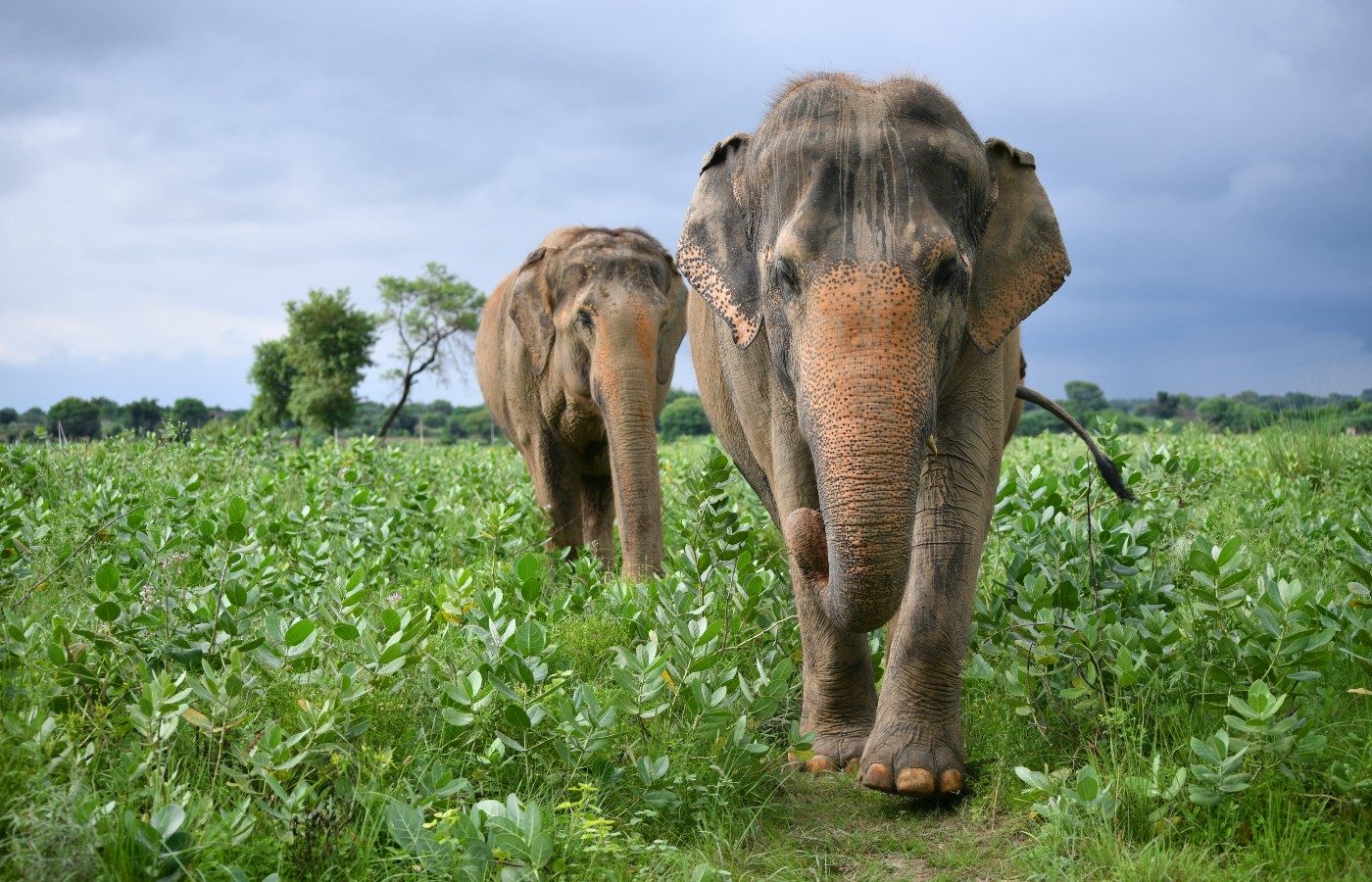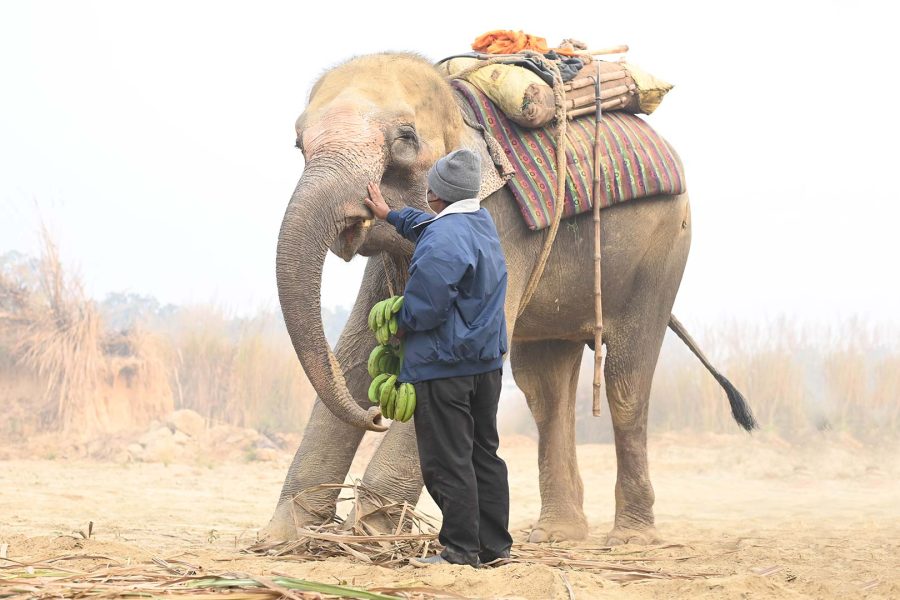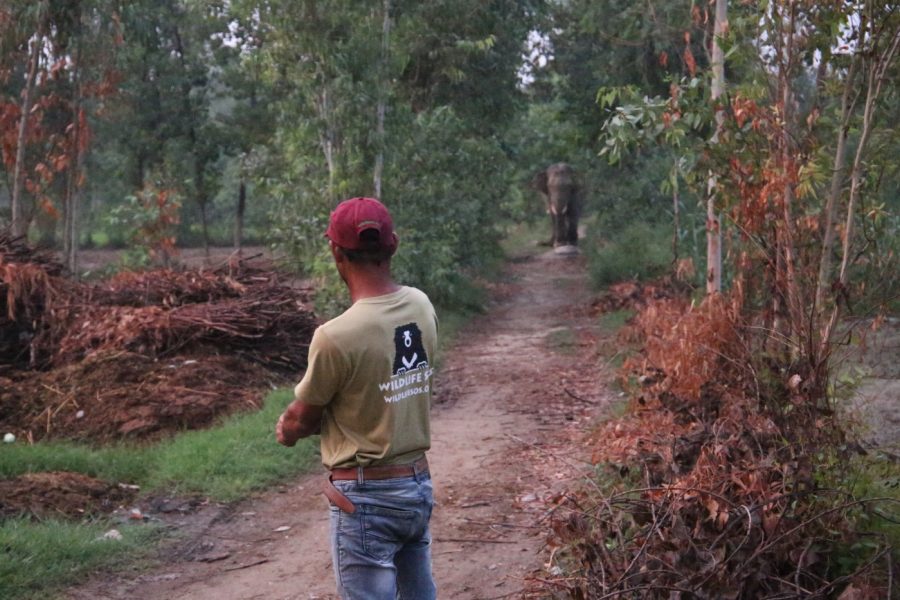Elephants are known for their colossal size, strength, complex behaviours, and remarkable intelligence. These highly social animals possess well-developed cognitive and sensory capacities adapted to their natural environments. In the wild, elephants lead dynamic lives, constantly engaged in activities related to foraging, grazing, and defending their territory to protect and nurture their young. Being highly food-motivated animals, they can spend up to 16 hours a day in searching and consuming food, which generally consists of roots, bark, fruit, leaves and different kinds of herbs.
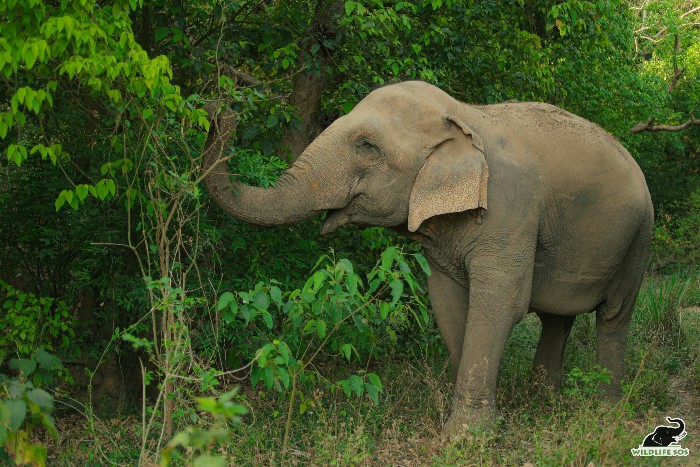
The task of managing rehabilitated elephants therefore becomes a formidable challenge. Meeting their basic needs is just the beginning; a stimulating environment is imperative to ward off inactivity, stereotypy, and boredom. Rescued elephants, having endured years of brutal captivity, require special attention to regain their natural instincts and well-being. Thus, Wildlife SOS incorporates a comprehensive enrichment programme for all the rehabilitated elephants.
Enrichment Programme for Elephants
Crafting an effective enrichment programme requires a nuanced understanding of individual histories and elephant biology. It aims to encourage species-appropriate behaviours, promoting optimal psychological and physical health. An enrichment may take various forms, such as designing naturalistic enclosures, fostering suitable social groups, and introducing stimuli like objects, sounds, and smells into the environment.
According to the Association of Zoos and Aquariums, enrichment in the context of elephant rehabilitation is defined as the “process for improving or enhancing the environment of elephants in the care of humans within the context of the elephant’s behavioural biology and natural history.” This process aims to simulate the wild environment, and stimulate an elephant’s brain and body.
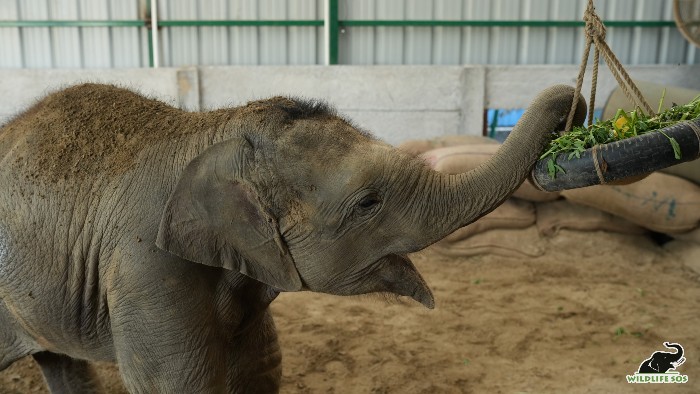
Through activities created around an enrichment, elephants explore their surroundings, enhance their problem-solving abilities and conduct friendly social interactions with their peers. These activities offer opportunities for elephants to seek shelter, forage, and exercise in a species-appropriate way, so that their natural behaviours are effectively recovered and retained. Our team ensures these magnificent beings are not merely surviving; they are thriving, learning, and, most importantly, rediscovering what it means to be an elephant again.
Layout of the Enclosure
Creating a thoughtfully designed enclosure is paramount in ensuring the comfort of elephants in a rehabilitation centre. Wildlife SOS prioritises maximising usable space to enhance the activity levels of the animals.
The strategic placement of key features such as water troughs and sheds within the enclosure plays a crucial role in making them move all across their field. As part of an environmental enrichment, water features, such as sprinklers and hose pipes, are introduced during warmer weather, offering elephants some respite from heat. This helps them overcome trials of temperatures to remain fresh and active. Natural inclusions, such as tall trees, shrubs, and logs, seamlessly create a link between their innate behaviour and the environment. Unlike concrete constructions, these elements are actively utilised by all elephants. Trees provide shade, and adequate exercise to the trunk muscles as well when elephants reach out to the hanging food-based enrichments. Multiple shrubs can be foraged on, and logs of wood or bamboo can be used in many playful ways.

At Elephant Conservation and Care Centre (ECCC), most of the elephant enclosures have jumbo pools for the gentle giants to take a leisurely bath in. In hot summer months, they may even spend several hours a day relaxing their limbs. Each pool is generally five to six feet deep, with nearly eight to ten steps that lead into a circular area that is 20 feet in diameter. Most enclosures are also equipped with a protected contact wall (PCW) to facilitate medical treatment or regular examinations. This specially designed wall is ten feet tall and nearly 15 feet long and enables secure interactions between the elephants and the team of caregivers and veterinarians.
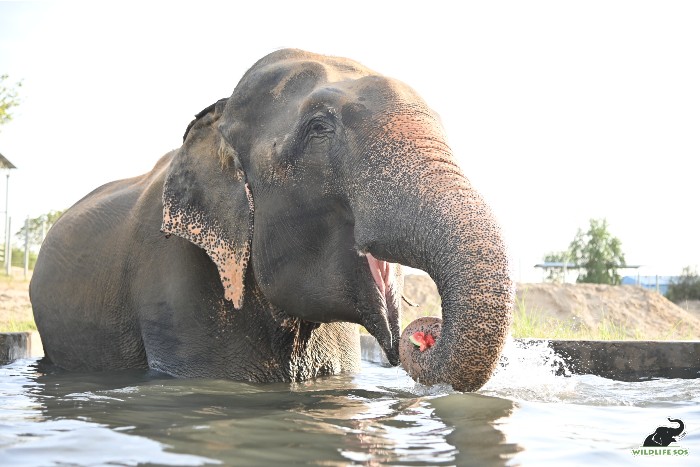
The spacious field of our resident elephants also have high mud beds that are maintained by our team. These provide support to the pachyderms to lie down and get up with ease. For those who suffer from severe osteoarthritis such as Lakshmi, the beds help distribute their weight, thus allowing them to stand up easily after resting. Residents like Arya and Zara have three mud beds in the field, with one being inside their shed.

Food-Based Enrichments
The incorporation of the five senses is crucial in planning enrichment activities. Elephants, with their keen sense of hearing, appreciate the sounds of the wild, from chirping of birds to the gush of water.
Forage set up in the enclosure carries a strong aroma that knocks on the olfactory sense of elephants. Tasty treats of delicious fruit and seasonal fodder are given to them as part of their enrichments, which motivate them to return for more. Enrichment activities also cater to the elephants’ sense of touch, allowing them to explore various textures like rubber and bark by solely using their highly sensitive trunks. Substrates like soil and mud in their fields allow them to indulge in the instinctual exercise of dust bathing. For our caregivers, these natural elements are also perfect to hide treats and other enrichment items to encourage the elephant’s foraging behaviour.

Food-based enrichments are extremely efficient since there’s no incentive quite like a delicious meal! These enrichments also provide a great incentive for the elephants to interact with each other in a friendly way. Following are some of the enrichment items teams at our elephant centres provide to the elephants:
- Feeder Cages
The team has installed feeder cages on the outer ends of each elephant enclosure, which require the elephants to carefully navigate their trunk through ports and over obstacles to access their food. Caregivers fill these metallic cages twice a day with soft, palatable fodder such as berseem and sugarcane. At the Elephant Hospital Campus (EHC), residing elephants Peanut and Coconut have four cage feeders placed widely apart from each other across the periphery. This arrangement allows the duo to walk across the enclosure to reach, and feast, on fresh fodder. In order to draw out the last bit of the food, they blow air through their trunks, which stirs the leftover towards the ports, allowing them easy access. At ECCC, our grand old dame Suzy often softens the stalks by whipping them against the feeder cage itself!

- Feeder Pipes
Different types of feeder pipes have been set up along the enclosure boundary for elephants to walk around and graze. These PVC (polyvinyl chloride) pipes are embedded in the ground, with a small portion of nearly a foot that extends above the surface. Our team adds chopped fruits, chickpeas, and sugarcane stalks in the pipes, and replenishes them once the lot is devoured. Each morning, Arya and Zara at EHC rush to extract the freshly added treats from the PVC pipe enrichments!

The second kind of pipes installed in elephant fields are made of galvanised iron (GI). Nearly a foot long, they are fused onto the enclosure’s steel posts, and caregivers stock them with fodder stalks. Chanchal’s field at ECCC has five of them that are nearly equally distant, enabling her to walk around and pull out her favourite forage!
- Hanging Nets
Hammock-like structures are usually hung nearly 10 to 12 feet from the ground, depending on the elephant’s height. After setting them up using a pulley system, the caregivers throw fodder stalks atop the hammocks. This structure is preferred by many residing elephants at our centres, like Suraj, Laxmi, Mia, Rhea, Maya, Phoolkali. Peanut and Coconut, however, have had several instances where they’ve managed to completely take down the hammocks!
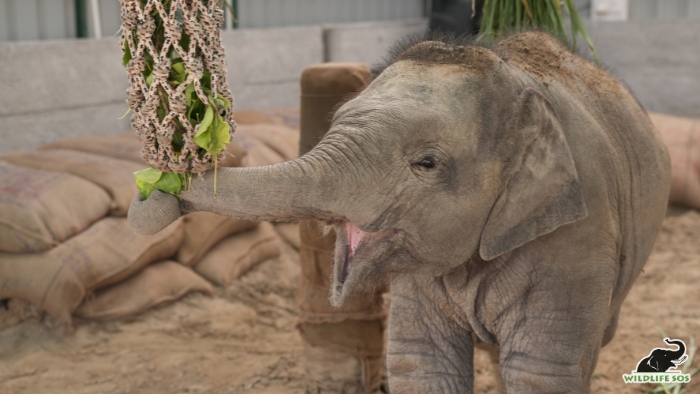
Sometimes, our team also sets up nets that have been carefully knit using silk strings, with a ring on either side. Generally four feet long, these are hung using long ropes with the help of a pulley. These nets are then filled with sugarcane or alfalfa crops, and elephants exercise their trunk and back muscles to procure these snacks. Laxmi and Phoolkali, famously known for their inquisitive nature, are often seen using their wisdom to open knots of the pulley so that the food simply falls out!
- Hanging Drums
Large plastic drums with one or more holes are set up in the field atop metallic poles. The holes are big enough to allow the elephants’ trunk to get inside the drum and pull out the fodder within. For the duo Arya and Zara, the pole is set nearly 12 feet high. One can see Zara going towards the hanging drum first, and bringing down sugarcane stalks. Soon, Arya joins her companion, and the two manage to quickly finish off the treats! Such enrichments make the elephants employ the strength and techniques of pushing, pulling, and even manipulating the objects to get a fruitful result. Maya and Phoolkali also spend a significant amount of time fidgeting with the hanging drum, which not only is an excellent exercise for them, but allows the two to cheerfully socialise and strengthen their bond!

- Hanging Tyres
Tyres, sliced in half, are safely suspended using ropes via a pulley system. The tyres are then dangled at varying heights. For Laxmi, these tyres are filled with treats like chopped fruits, peanuts, and dates. The constant rotation of this enrichment stimulates Laxmi to use her physical and mental skills in order to procure each tempting edible.
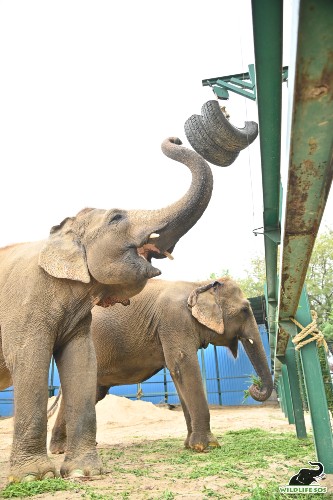
- Rolling Cages
Drum-shaped cages that can be rolled by elephants are dangled from poles nearly 10-12 feet high. These cages have small ports or holes, allowing elephants to run through their trunks. However, Emma, our nearly 43-year-old resident, rolls the drum by striking her trunk and waits for treats to fall down! Chanchal, on the other hand, enjoys shuffling and fiddling with the drum, so much so that it has been dismantled multiple times! Our team has now placed her cage slightly higher, which makes it an exercise for her.

- Wooden Logs
Dried up tree trunks are picked up and lodged nearly four feet into the ground. The team ensures that up to eight feet of the trunk remains above the earth. These large logs in the middle of their fields are multifunctional for elephants — they provide surfaces for them to rub and scratch themselves on, as well as become anchors for hanging suspending enrichments. However, elephants often find innovative ways to preoccupy themselves with these enrichments. The caregivers frequently observe Arya resting her trunk on the log and catching a quick nap during the day. Our residents at EHC, Pari and Priyanka, wrestle with the logs to take them down within a few days after they are set up!

Developing Specialised Enrichments
It becomes evident that enrichments are not just about offering playtime to the pachyderms, it’s a nuanced and dynamic approach for the welfare of these gentle giants. To maintain their interest, enrichment items are periodically removed, repositioned, or modified. The entire elephant care staff works in collaboration to design enrichments for elephants, which are novel and specialised for each individual. Caregivers understand the needs, and discomfort, of our resident elephants and manoeuvre the enrichments for them accordingly. Bamboo enrichments, for instance, are not placed for Mia and Rhea, since they undergo consistent treatment for their damaged foot pads.

For elephants who have spent a longer time under our care, the team creates more complex and demanding enrichments to keep their inquisitive nature alive. When Peanut and Coconut had arrived at the Elephant Hospital in 2015, their feeder cages had ports with a diameter of eight centimetres. Now, after ample practice of extracting fodder stalks, our team decided to move the location of the ports and reduce their size to nearly four centimetres, clicking a refresh button for the two!

At Wildlife SOS, ideating and executing enrichments embodies a holistic philosophy dedicated to the comprehensive care of elephants. This philosophy is manifested in the intricate design and implementation of enrichments that cater to every facet of their physical and psychological needs. Crafting such an enriching environment is no small feat — it demands an extensive investment of time, effort, and resources. From creating stimulating structures to developing specialised activities, each enrichment initiative is a labour of care that consumes substantial resources. To continue fostering this nurturing environment and contributing to the ongoing healing journey of these majestic pachyderms, we rely on the generosity of individuals like you. You can continue to support us by making a donation here.

